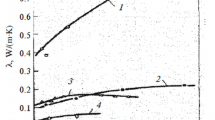Conclusions
-
1.
The specific electrical resistance of certain carbon composition materials decreases with increasing temperature.
-
2.
Flat heaters fabricated from a carbon/carbon-type material possess anisotropy of electrical conductivity.
-
3.
Current conductors and heaters formed from a carbon/carbon-type material are suitable for service under a moderate vacuum (0.133–133 Pa).
Similar content being viewed by others
Literature cited
O. L. Razumov, V. I. Kostikov, M. B. Gutman, and A. L. Pushkin, "Composition carbon/carbon materials, and their special production characteristics and use," Elektrotekh. Prom. Ser. "Élektrotermiya," No. 8 (246), 7–10 (1983).
L. G. Dedenko and V. V. Kerzhentsev, Mathematical Processing and Formatting of Experiment Results [in Russian], Moscow State Univ. (1977).
A. N. Zaidel', Elementary Evaluations of Measurement Errors [in Russian], Nauka, Leningrad (1967).
Additional information
All-Union Scientific-Research Institute of Electrothermal Equipment. Scientific Research Institute of Graphite. Translated from Metallovedenie i Termicheskaya Obrabotka Metallov, No. 2, pp. 62–63, February, 1986.
Rights and permissions
About this article
Cite this article
Marmer, É.N., Krivoshein, D.A. & Vavilkina, S.V. Composition carbon materials in vacuum-electric-furnace designs. Met Sci Heat Treat 28, 160–161 (1986). https://doi.org/10.1007/BF00717543
Issue Date:
DOI: https://doi.org/10.1007/BF00717543



